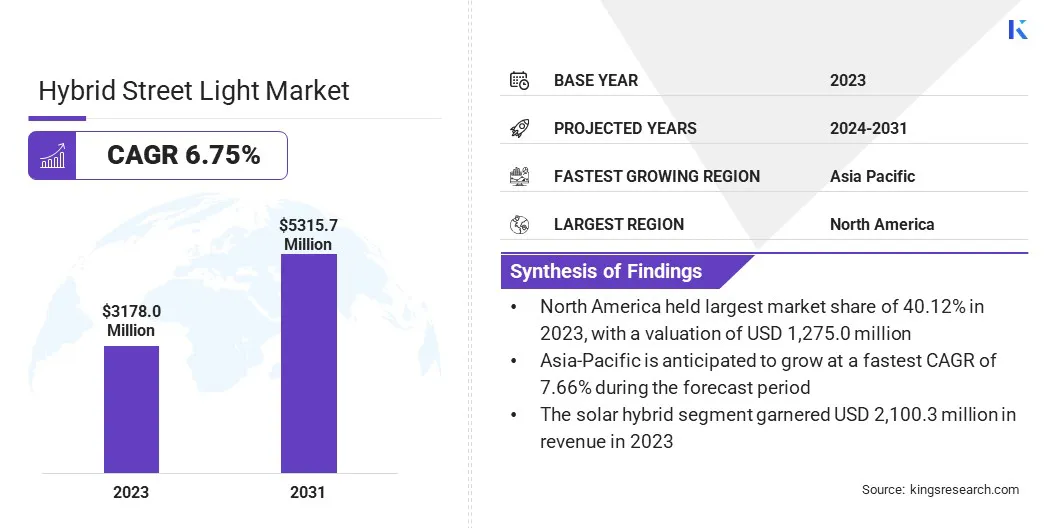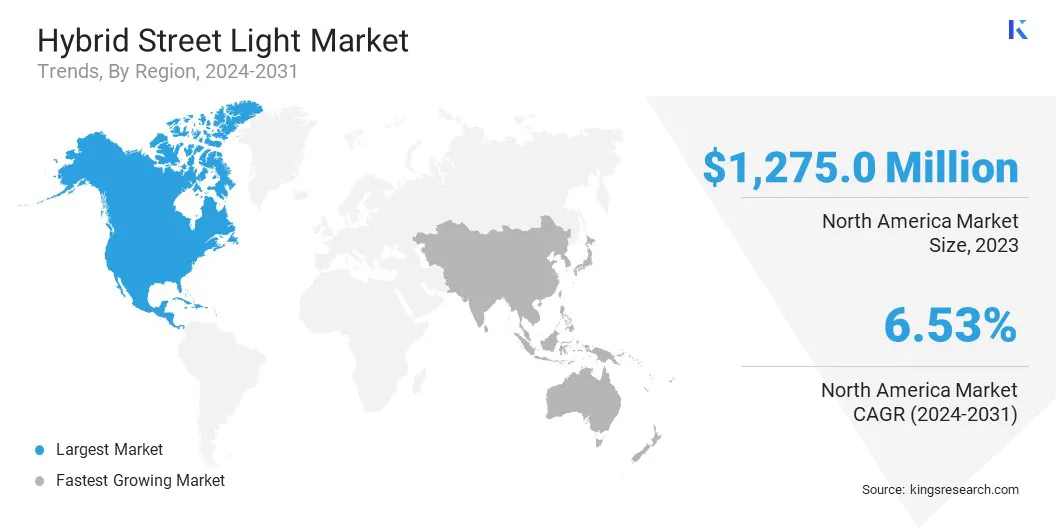Market Definition
The hybrid street light market encompasses street lights that combine renewable energy sources and conventional electricity. These lights typically use solar panels to generate power, store excess energy in batteries, and may rely on grid power as a backup. This market focuses on energy efficiency, sustainability, and reducing costs for public lighting.
Hybrid Street Light Market Overview
The global hybrid street light market size was valued at USD 3,178.0 million in 2023, which is estimated to be valued at USD 3,365.1 million in 2024 and reach USD 5,315.7 million by 2031, growing at a CAGR of 6.75% from 2024 to 2031.
Cost savings are a major growth driver of the market, as solar integration and energy storage reduce reliance on the grid. This leads to lower electricity bills for municipalities, making hybrid systems a more affordable and sustainable lighting option.
Major companies operating in the global hybrid street light Industry are Signify Netherlands B.V., Armadillo Lighting, Shenzhen Luxman Light CO.,Ltd, Devang Solaar Pvt Lt, Aura Energy, HeiSolar, Asten Solar, Fevino Industries LLP, Safield Distribution Ltd, NEWGARDEN SPAIN, SL, SunMaster, Havells India Ltd., Crompton Greaves Consumer Electricals Limited, Bajaj Electricals Limited, and Halonix Technologies Private Limited.
The market is registering significant development, due to the increasing adoption of energy-efficient and sustainable lighting solutions. Governments and municipalities are transitioning to hybrid street lights to reduce energy consumption and cut costs, driven by both environmental and economic factors.
- As per the PIB press release dated August 2024, the Street Lighting National Programme in India aims to replace conventional street lights with smart, energy-efficient LED streetlights across the nation. By June 30, 2024, the Energy Efficiency Services Limited (EESL) successfully installed 1,31,10,745 LED streetlights, leading to an estimated energy savings of approximately 8,806 Million Units (MU) annually.
Advancements in solar panel technology, battery storage, and LED lighting further enhance the appeal of these systems. The market is expanding globally, with urbanization and infrastructure development boosting the demand for eco-friendly, low-maintenance, and cost-effective street lighting solutions in both developed and emerging regions.

Key Highlights:
- The global hybrid street light market size was valued at USD 3,178.0 million in 2023.
- The market is projected to grow at a CAGR of 6.75% from 2024 to 2031.
- North America held a market share of 40.12% in 2023, with a valuation of USD 1,275.0 million.
- The solar hybrid segment garnered USD 2,100.3 million in revenue in 2023.
- The hardware segment is expected to reach USD 3,441.8 million by 2031.
- The private sector segment is anticipated to register the fastest CAGR of 7.62% during the forecast period.
- The market in Asia Pacific is anticipated to grow at a CAGR of 7.66% during the forecast period.
Market Driver
"Urbanization and Infrastructure Development"
Urbanization and infrastructure development are key growth drivers of the hybrid street light market, as rapidly expanding cities require efficient and sustainable lighting solutions.
- According to the World Bank Group, approximately 56% of the global population currently resides in cities. This urbanization trend is expected to persist, with the urban population more than doubling by 2050. By that time, nearly 70% of the world’s population will be living in urban areas.
The demand for smart, eco-friendly street lighting has surged, due to population growth and urban sprawl. Hybrid street lights, combining solar power with grid electricity, offer a cost-effective and reliable solution to meet the lighting needs of growing urban areas. This shift not only addresses energy demands but also aligns with sustainability goals, enhancing urban living conditions while reducing environmental impact.
- In September 2024, ITI Limited received an order from BREDA to supply and install 1,00,000 solar street light systems in Bihar. This adds to the 80,000 systems currently being executed under the "Mukhyamantri Gramin Solar Street Light Yojana.".
Market Challenge
"Lack of Public Awareness"
A key challenge faced by the hybrid street light market is the lack of awareness about its benefits among decision-makers, which can hinder widespread adoption. Many municipalities and local authorities may not fully understand the cost-saving, sustainability, and long-term advantages of hybrid systems.
Comprehensive awareness campaigns, including case studies, pilot projects, and workshops, can be implemented. Educating policymakers and key stakeholders about the environmental and economic benefits of hybrid street lights can foster faster acceptance and wider deployment.
Market Trend
"Technological Advancements"
Technological advancements in solar panels, battery storage, and LED technology are driving significant trends in the hybrid street light market. Improved solar panel efficiency allows for better energy capture, even in less sunny areas.
Enhanced battery storage systems provide longer-lasting and more reliable power, ensuring consistent lighting even during cloudy days or at night. Additionally, innovations in LED technology have made streetlights more energy-efficient and durable.
These advancements are making hybrid street lights more viable, cost-effective, and appealing to municipalities aiming for sustainable, smart lighting solutions.
- In August 2024, Crompton Greaves partnered with Eastern Engineering to implement a solar street lighting project in Birmitrapur Municipality, Orissa. The 5-kilometer installation uses advanced solar-powered lights, enhancing safety and sustainability with durable, efficient, and eco-friendly technology.
Hybrid Street Light Market Report Snapshot
|
Segmentation
|
Details
|
|
By Power Source
|
Solar Hybrid, Wind-Solar Hybrid, Other Hybrid System
|
|
By Component
|
Hardware (Solar Panel, LED Lamp, Battery, Controller Unit, Others), Software
|
|
By End-use Industry
|
Municipalities, Private Sector, Others
|
|
By Region
|
North America: U.S., Canada, Mexico
|
|
Europe: France, UK, Spain, Germany, Italy, Russia, Rest of Europe
|
|
Asia Pacific: China, Japan, India, Australia, ASEAN, South Korea, Rest of Asia Pacific
|
|
Middle East & Africa: Turkey, UAE, Saudi Arabia, South Africa, Rest of Middle East & Africa
|
|
South America: Brazil, Argentina, Rest of South America
|
Market Segmentation:
- By Power Source (Solar Hybrid, Wind-Solar Hybrid, Other Hybrid System): The solar hybrid segment earned USD 2,100.3 million in 2023, due to the increasing adoption of renewable energy sources for cost-effective and sustainable street lighting solutions globally.
- By Component (Hardware, Software): The hardware segment held 65.91% share of the market in 2023, due to higher demand for durable solar panels, LED lights, and batteries required for hybrid street lighting systems in various regions.
- By End-use Industry (Municipalities, Private Sector, Others): The municipalities segment is projected to reach USD 3,162.0 million by 2031, due to the growing government investments in smart and energy-efficient street lighting to reduce energy costs and environmental impact.
Hybrid Street Light Market Regional Analysis
Based on region, the global market has been classified into North America, Europe, Asia Pacific, Middle East & Africa, and Latin America.

North America accounted for a hybrid street light market share of around 40.12% in 2023, with a valuation of USD 1,275.0 million. North America dominates the market, driven by strong governmental support for sustainable energy solutions and smart city initiatives.
The region’s focus on reducing carbon emissions, alongside significant investments in infrastructure, has accelerated the adoption of hybrid street lights. U.S. and Canadian municipalities, in particular, are increasingly deploying solar and hybrid systems to enhance energy efficiency and lower maintenance costs. These factors, combined with advanced technological infrastructure, solidify North America’s leadership in the global market.
- In November 2024, L&T Technology Services (LTTS) joined forces with the Colorado Smart Cities Alliance to enhance smart city initiatives. This partnership focuses on creating energy-efficient, sustainable urban infrastructure, utilizing advanced technology to optimize resource use and reduce environmental impact, potentially boosting the demand for hybrid street lighting.
The hybrid street light Industry in Asia Pacific is poised for significant growth at a robust CAGR of 7.66% over the forecast period. Asia Pacific is the fastest-growing region for the market, primarily due to rapid urbanization and increasing demand for energy-efficient lighting solutions.
Countries like China, India, and Japan are investing heavily in renewable energy technologies, including hybrid street lights, to address growing energy consumption and environmental concerns.
Government initiatives, such as India’s Smart Cities Mission and China’s green development plans, are fostering the expansion of hybrid street lighting. Thse factors, combined with technological advancements and cost-effective solutions, are driving the market across the region.
Regulatory Frameworks
- In the U.S. the Department of Energy (DOE) establishes energy-efficiency standards for certain appliances and equipment, and currently covers more than 70 different products.
- Environmental Protection Agency (EPA's) State Energy and Environment Guide to Action offers real-world best practices to help states in the U.S. design and implement policies that reduce emissions associated with electricity generation and energy consumption.
- The Ecodesign for Sustainable Products Regulation (ESPR) aims to significantly improve the sustainability of products in the EU market by improving their circularity, energy performance, recyclability, and durability.
Competitive Landscape:
The global hybrid street light market is characterized by a large number of participants, including established corporations and rising organizations. Companies in the market are launching innovative solutions like wind-solar hybrid lights, combining wind turbines with solar panels to generate renewable energy for street lighting.
These new launches aim to provide more reliable and consistent lighting, especially in areas with intermittent sunlight, while improving energy efficiency and sustainability.
- In July 2023, India-based WindStream Energy Technologies introduced a hybrid wind-solar-powered LED street light system. Installed at the Hyderabad campus of the National Institute of Rural Development, it offers higher energy efficiency, with options available in 20W, 40W, and 60W.
List of Key Companies in Hybrid Street Light Market:
- Signify Netherlands B.V.
- Armadillo Lighting
- Shenzhen Luxman Light CO.,Ltd
- Devang Solaar Pvt Lt
- Aura Energy
- HeiSolar
- Asten Solar
- Fevino Industries LLP
- Safield Distribution Ltd
- NEWGARDEN SPAIN, SL
- SunMaster
- Havells India Ltd.
- Crompton Greaves Consumer Electricals Limited
- Bajaj Electricals Limited
- Halonix Technologies Private Limited
Recent Developments (Installation/Project Completion)
- In August 2024, Desiccant Rotors International Pvt. Ltd. installed solar street lights in Dadhikar village, Alwar, as part of its CSR initiative. The project aims to enhance safety, improve local infrastructure, and benefit over 7,500 villagers, particularly in areas vulnerable to wildlife encounters.
- In April 2024, EnGoPlanet and Calhoun County announced the near completion of the largest solar street light installation in the U.S. The project includes 300 solar street lights and 20 solar poles with cameras, enhancing public safety and promoting sustainable energy.


